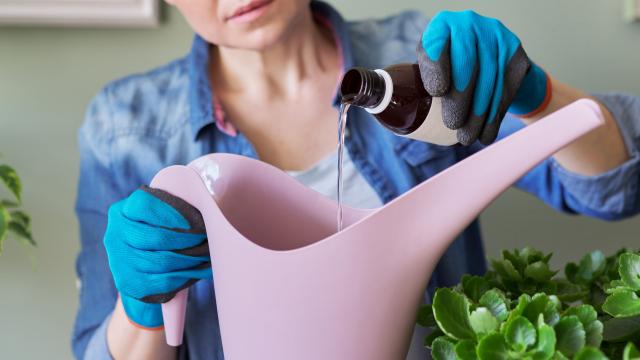Hydrogen peroxide is a household disinfectant made up of two parts hydrogen and two parts oxygen. The high oxygenation creates a foaming action when it is poured on, jarring loose bacteria and more deeply penetrating porous surfaces, helping to cleanse them. When poured on the skin, all that foam makes us believe the solution is doing something good for our cuts and bruises, too — but it’s killing both the good and bad parts of the skin, and can actually prevent a wound from healing.
As we’ve reported in the past, it’s better to use soap and water for your scrapes and cuts. Hydrogen peroxide should be kept with your cleaning supplies, not in your medicine cabinet. Here are better uses of hydrogen peroxide that won’t damage your skin.
Sanitiser (but not hand sanitiser)
According to the U.S. Centre for Disease and Control and Prevention (CDC), Hydrogen peroxide breaks down fungi and bacterial activity within five minutes of use, making it a powerful disinfectant — but not for your hands.
Sanitise sponges, toothbrushes, and works against COVID-19
Soak your toothbrush for three to five minutes in a glass of hydrogen peroxide after use to kill any germs or viruses. This cleaning method is especially recommended during times when you might be sick. Disinfect sponges by combining equal parts water and hydrogen peroxide in a shallow bowl. Place the sponge into the bowl to soak for ten minutes, then rinse. You can also do this using undiluted hydrogen peroxide — just be sure to rinse your sponge thoroughly.
The University of North Carolina (UNC) released a helpful infographic for household items that can be used against the COVID-19 virus in your home. Hydrogen peroxide is listed as a disinfectant for soft materials. When mixed with equal parts water, household hydrogen peroxide can be sprayed on items to kill COVID-19 and other viruses. UNC mentions letting the items sit for 20 minutes before use increases the virus-killing effects.
Clean mould in the bathroom
The antimicrobial works against mould build-up in your bathroom. Use hydrogen peroxide in a spray bottle (straight from the bottle; no need to dilute it), let sit for 30 minutes, then wipe away. The bacteria will be toast, leaving you free to clean the area to remove any staining the mould may have caused.
Keeps house plants free of fungi and disease
Plants can thrive when sprayed with a hydrogen peroxide solution. Add one teaspoon of hydrogen peroxide for every cup of water to a spray bottle. Spritz your plants with this solution to promote growth and save plants from fungal infections. Healthline suggests soaking your seeds in hydrogen peroxide to increase gestation when planting.
Deep cleaning
Wash veggies
Add one-sixteenth a cup of hydrogen peroxide per one litre of water. Soak your veggies in the solution for ten minutes, then rinse well. Doing so will remove dirt, pesticides, and bacterias like E.coli. Hydrogen is a safer alternative to bleach when it comes to cleaning organic products.
Remove stains from cookware
Pots and pans tend to accumulate buildup over time, creating black, caked-on crud. Cover your pot or pan with a paste made up of hydrogen peroxide and baking soda. Let the pan sit for 20 – 30 minutes, then rinse. It may take a bit of scrubbing, but the residue will eventually be stripped away and your pots will look a lot closer to new.
Grout cleaning and whitening
Spray grout with undiluted household hydrogen peroxide. Wait 10 -20 minutes, then scrub with a rough sponge — or, better yet, an old toothbrush — to remove the dirt and grime. Repeat as many times as needed for desired results.
[referenced id=”1040027″ url=”https://www.lifehacker.com.au/2020/12/the-best-ways-to-clean-grout/” thumb=”https://www.gizmodo.com.au/wp-content/uploads/sites/4/2020/12/15/clean-grout-300×168.png” title=”The Best Ways to Clean Grout” excerpt=”Most substances wipe off tile pretty easily, but getting the surrounding grout back to its original pearly white state is much harder. Because it is so narrow and coarse, scrubbing grout lines clean can be a hassle (unless you like spending hours hunched over with a toothbrush). Luckily, we have…”]
Body and pet health
Generic household hydrogen peroxide contains 3% of the chemical compound per bottle. This amount of hydrogen peroxide is generally safe for household and bodily use.
Rinse for oral hygiene
The FDA approved small amounts of hydrogen peroxide for the cleaning of oral wounds, clearing the use of hydrogen peroxide as an antiseptic mouthwash. Swish a tablespoon of hydrogen peroxide for 10 minutes to help relieve canker sores and freshen your breath. Do not swallow — although small amounts aren’t harmful, ingesting large amounts can be toxic.
Ear wax removal
Hydrogen peroxide acts as a drying agent to remove ear wax build up. Simply tilt your head and pour in a few drops of hydrogen peroxide using a liquid dropper. Sit for a few minutes while the solution foams inside the ear. Then take a napkin, tilt your head the other way, and wipe what comes out. Be sure all liquid is removed from the ear.
Poison control for your dog
The American Veterinary Medical Association conducted a study on the effectiveness of inducing vomiting in dogs using hydrogen peroxide, finding 48% of ingested agents were recovered when dogs were given the chemical to expel them. If your dog has eaten something hazardous, call your veterinarian immediately — but if it’s an emergency, they may advise you to use hydrogen peroxide to get the dog to vomit up whatever it is they shouldn’t have eaten.

Leave a Reply
You must be logged in to post a comment.